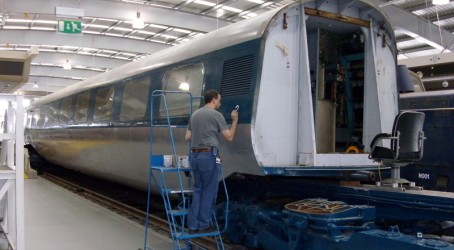A ground-breaking train that was the first in the world to be fitted with a tilting mechanism is to be the recipient of a major engineering award later this week.
The Advanced Passenger Train-Experimental (APT-E) is to receive an Engineering Heritage Award by the Institution of Mechanical Engineers.
The APT-E was developed in the 1970s and was the world’s first self-propelled active tilting train, effectively making it the pre-cursor to tilting trains in current use like the Pendolino.
It was powered by gas turbines, the only multiple unit used by British Rail to use this technology.
However, political and managerial pressure led to three APT-P trains being launched in 1981 when, in hindsight, they were not ready for service, leading to technical problems and poor reliability upon launch.
A notorious press trip, where many invited journalists riding the first demonstration train suffered from high levels of motion sickness, created much bad publicity. And on one test run with the press, certain units of the train 'stuck' tilted to one side for parts of the journey. British Rail eventually terminated the project.
However, Professor Isobel Pollock, past president of the IMechE, who will be presenting the award, said that despite its problems, the APT-E pioneered some hugely innovative ideas in railway transport, which still live on today.
She said: “The train is testament to the fact that the UK is home to some of the most inventive engineering innovations in the world.
“The train marked a number of world firsts, including being the first self-propelled active tilting train; the first train to have computer designed wheelsets and active suspension; and the first train to run at over 100 mph on any track without side-to-side instability.
“Sadly politics, industrial relations and poor publicity lead to the demise of the APT project, but its legacy has been integral to the development of modern railway travel.”
Paul Leadley, from the APT-E Conservation and Support Group said: “At long last the APT project is to be recognised as the peak of British railway engineering and design, technology which is now in use world-wide on a day to day basis.
“Managerial and political issues caused the APT project to be scrapped, not the technology. As Sir Peter Parker (past Chairman of British Rail), once said, we have solved a very difficult problem by developing the APT, now let’s take pride in it.”
The APT-E Conservation and Support Group has been working on the restoration of an APT-E train for over 13 years, which also includes correcting the public’s views towards the APT project as a whole. Pollock said the award would be a fitting tribute to all who worked on the APT-E, and the entire APT project.
Anthony Coulls, Senior Curator of Rail Vehicles at the National Railway Museum said: “The APT-E is often a misunderstood part of our collection. The Institution’s award will raise its profile, quite rightly and show the importance of the train in the development of high speed rail travel as we know it.”
The award will be presented by Professor Isobel Pollock on Friday 24 May, at a special ceremony at Locomotion, the National Railway Museum at Shildon, County Durham.

About the APT-E
The APT was an experimental tilting high speed train developed by British Rail during the 1970s and early 1980s. The introduction into service of the Advanced Passenger Train was to be a three-stage project:
Phase 1
The development of an experimental APT, the APT-E, which was completed.
Phase 2
the introduction of three prototype trains, known as the APT-P, into revenue service on the Glasgow-London route. The APT-P enjoyed only limited service due to bad publicity.
Phase 3
The introduction of the Squadron fleet designated APT-S. This phase did not occur.
- For more information about this award-winning train see www.apt-e.org